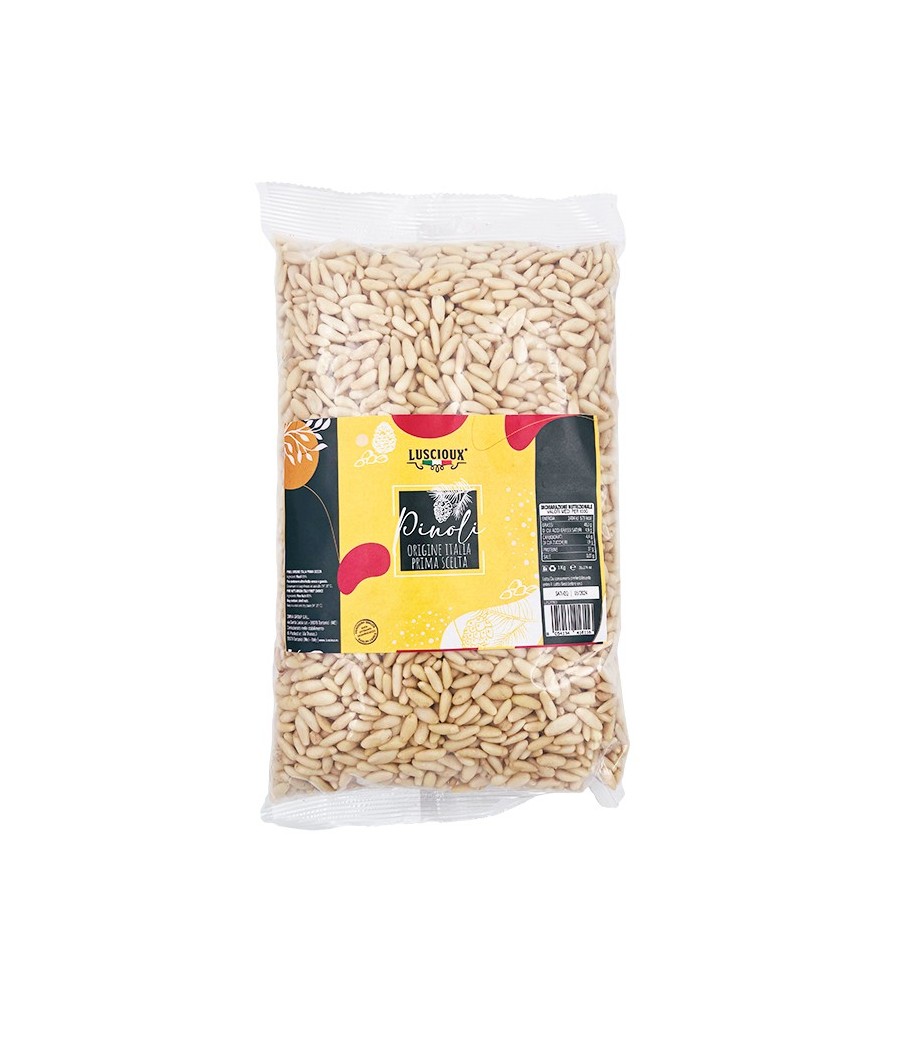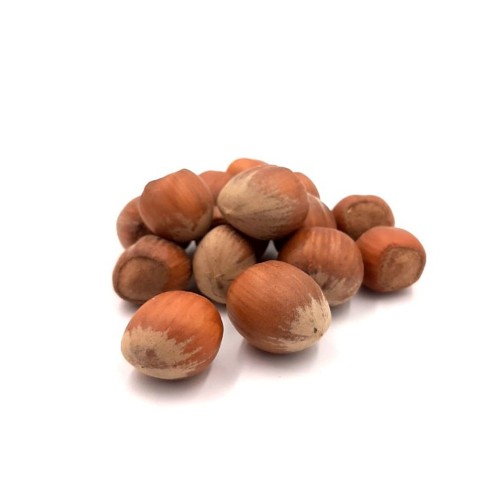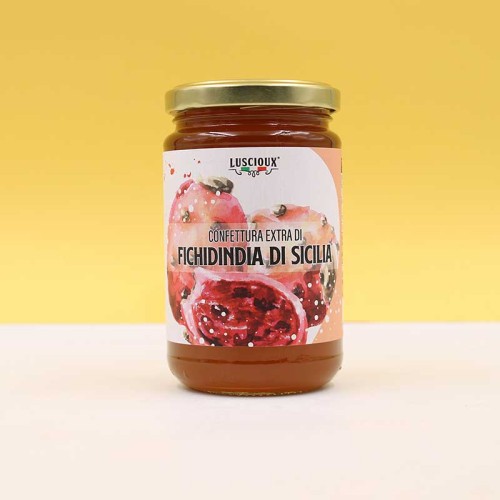Pine Nuts First Choice Italy
 Security policy
Security policy
Transparency and reliability - Encrypted information (SSL Certificate)
 Delivery policy
Delivery policy
Fast shipping with delivery in 1- 4 working days.
 Return policy
Return policy
24/7
Pine nuts are the edible seeds of some varieties of pine. High protein power. Ideal for the preparation of both sweet and savory baked goods.
Data sheet
- Product
- Pine nuts
Specific References
- ean13
- 8054134416116
Nutritional values
| Ingredients | Pine nuts |
| Method of conservation | Keep in a cold and dry place. |
| Nutrition declaration | average values per 100 g: |
| Power | 2404 kJ / 579 kcal |
| Fats | 45.1 g |
| of which saturated fatty acids | 4.9g |
| Carbohydrates | 4.4g |
| of which sugars | 1.9g |
| Fibers | 4.4g |
| Protein | 37 g |
| Salt | 0.01 g |
| Phosphorus | 816 mg (117% NRV*) |
| Zinc | 11mg (110% NRV*) |
| Magnesium | 380 mg (101% NRV*) |
| Directions | The advice given IS NOT IN ANY WAY TO BE CONSIDERED OF MEDICAL/PRESCRIPTIVE VALUE. The information provided is for informational and informative purposes only, therefore they are not intended in any way to replace medical advice. In the presence of pathologies you should always consult your doctor. |
| Origin | Italy |
| Nutrients | Phosphorus, Magnesium, Zinc |
| Vnr | *Nutritional Reference Value |
| Label and packaging | The images are included for illustrative purposes, the product may undergo changes based on stock availability and the selected weight. |
| Product | Pine nuts |
Curiosity
THE pine nuts they are the edible seeds of some species of pines, trees belonging to the Pinaceae family. There are about 20 species of the genus that produce seeds large enough to justify their cultivation. In Europe there are two species of pine exploited. The best is the stone pine (Pinus pinea), which is not by chance also called "pine nut pine". The stone pine (Pinus cembra) produces large seeds, but lives in more difficult areas. Let's take a closer look at the stone pine: it is a typical tree of the areas surrounding the Mediterranean Sea, in particular of the northern coasts where it forms vast pine forests. It rises up to 25m, although the most common height is 12-20m. It has a short trunk and a large, spreading, globe-like crown, which becomes more and more umbrella-like over time.
The leaves are flexible needles, paired and usually 10 to 20 cm long. The cones, also called pine cones, are 8-15 cm long, ovoid and large. They take 36 months to mature, more than any other pine. They open when ripe to let out the seeds. The latter, the pine nuts, are large, 2 cm long, light brown in color with a shell covered by a dark sheath that is easy to scratch and have a rudimentary 5 mm wing that comes off easily. The wind is unable to carry the seeds, which are dispersed by animals, typically birds and today mostly by men. In Italy it is grown practically everywhere, with the exception of mountainous areas.
He naturalized in Southern Africa , where it is considered invasive and commonly planted in California, Australia and Western Europe as far south as Scotland. Currently the pine is also cultivated as an ornamental plant, as well as for the consumption of the seeds. European pine nuts can be distinguished from Asian ones by their greater length compared to the circumference: Asian pine nuts are squat, somewhat more similar in shape to corn kernels. Pine nuts are known for their large size and ease of shelling. In the United States, the P. edulis species became famous thanks to the trading post system and the Navajo people, who used pine nuts as a bargaining chip.
Pine nuts are essential for pesto and various other dishes including sweets like cakes.
Internationally this seed is often added to meat, fish, salads and vegetable dishes or in baking bread. In Spain, a dessert is made consisting of small marzipan balls covered with pine nuts, brushed with egg and then cooked quickly. Pine nuts are present in the salade landaise of southwestern France. Pine nut coffee, known as piñón, is a specialty that can be enjoyed in the southwestern United States, especially in New Mexico, and is typically a strong roast coffee with a deep nut flavor; here the toasted and lightly salted pine nuts are also sold as snacks on the streets of the cities.
In Middle Eastern cuisine, the use of pine nuts is reflected in a wide variety of dishes, such as kibbeh, samosa and desserts such as baklava.
Sources
Nutspaper "Pine Nut" 2/2015
History
The European cultivation of Pinus pinea , for the consumption of pine nuts, dates back over 6000 years. Pine nuts are called piñones in Spanish and pine nuts in English. In various areas of Italy they are called by other names such as “pinoccoli” or “pinocchi”, from which the name of the famous Pinocchio puppet seems to derive. Due to the high number of specimens in Italy , the stone pine is considered by many to be the symbolic tree of the country, so much so that in the Anglo-Saxon states it is called "Italianstone pine" and in France "Pin d'Italie".
Pinus Pinea pine nuts have been used in the Mediterranean region as a food product for over 2,000 years. The first significant traces of their use date back to 79 BC in the ruins of Pompeii, where they were considered such a noble and genuine element as to be remembered in mythology as a fruit loved by Bacchus. In Roman times they were then included in many culinary recipes, in the creation of wines and used in salads and desserts. The pine, from the western basin of the Mediterranean, has spread to the east, finding the ideal habitat in many areas of Italy. However, its true origins are shrouded in mystery: the prevailing theses assert that it originates from the western Mediterranean or from north-western Africa, however not native to our peninsula.
On the other hand, the means by which it spread in Italy, throughout the Mediterranean basin and beyond is safe and proven: the Etruscans . Tree symbol par excellence of Italy, it appeared in fact following this fascinating people of seafarers and traders, characterizing their settlements right from the start. Pine cultivation was later increased during the Roman Empire , where it was worshiped for its elegant beauty and the importance it played in lumber production and resin harvesting. The result of the Etruscan and Roman influence is evident today throughout the peninsula, especially in some areas where there are large pine forests such as the well-known Pineta Sacchetti in the urban area of Rome, or such as the ancient pine forests of Castiglione della Pescaia (GR). and of Tarquinia (VT).
Outside of Italy, the pine was celebrated by the Phrygians, a people originating from central Anatolia, who loved it for its fruits with which an intoxicating wine was prepared. In Greece , pine cones were instead used during the propitiatory festivals of fertility, during which they were thrown into pits dug in the earth together with other objects, symbolizing the male attribute with their shape.
Sources
Nutspaper "Pine Nut" 2/2015
storage
You can store natural pine nuts in cool, dry places, away from sources of heat and humidity. Here are 4 useful tips:
- The ideal condition for maintaining natural pine nuts is in a refrigerated environment . Natural pine nuts can also be stored without problems at room temperature during the winter season given the low temperatures. During the summer, on the other hand, it is advisable to keep it in the fridge or in the coolest possible place, as the increase in temperatures could favor the deterioration of the products.
- The ideal container in which to store natural pine nuts is glass . In fact, thanks to its constitution it is impenetrable to chemical and gaseous agents, and having excellent thermal insulating capacity it maintains the initial temperature for a longer time compared to other materials. If the glass is colored, so much the better: using colored glass prevents the entry of some wavelengths of light (including ultraviolet light) and therefore some nutritional and organoleptic characteristics remain unaltered.
- The type of closure of the container is also important: an airtight cap ensures that the food is protected from excessive contact with oxygen which can lead to lipid oxidation and which can be essential for aerobic bacteria.
- The environment should always be well ventilated : by ventilating the rooms, the internal humidity that escapes from the window is kept under control, guaranteeing the right balance, which helps to discourage the onset of moulds.
Recommended doses
30 g of pine nuts provide:
- 35% of the reference nutritional value of Phosphorus;
- 32% of the reference nutritional value of Zinc;
- 30% of the nutritional reference value of Magnesium.
Individual needs vary according to age, gender, weight and physical activity. A varied and balanced diet and a healthy lifestyle are the basis of your well-being.
Property
100g of pine nuts contain:
- Niacin (2.4 mg - 15% NRV)
- Vitamin B6 (0.49 mg - 35% NRV)
- Potassium (750 mg - 38% NRV)
- Thiamine (0.53 mg - 48% NRV)
- Iron (9.5 mg - 68% NRV)
- Vitamin E (11 mg - 92% NRV)
- Magnesium (380 mg - 101% NRV)
- Zinc (11mg - 110% NRV)
- Phosphorus (816 mg - 117% NRV)
- Copper (3.1 mg - 310% NRV)
- Manganese (8.8 mg - 440% NRV)
No customer reviews for the moment.






